The Etruscans
Etruscan Language and Literature
Home Cities History Art Hagiography Contact
The Etruscans: Main page Etruscan Language and Culture


The Etruscans
Etruscan Language and Literature
Home Cities History Art Hagiography Contact
The Etruscans: Main page Etruscan Language and Culture
Etruscan Language
As mentioned in my main page on the Etruscans, they can be identified by their shared language, which is unrelated to almost any other for which we have evidence. In particular, unlike Latin and the other Italic languages spoken by their neighbours, it does not belong to the group of languages designated as Indo-European. Unfortunately, no literary works in Etruscan survive, so students of it are reliant on the evidence of surviving inscriptions. Although there are probably more than 10,0000 of these, dating back to the 7th century BC, they are short and/or highly specialised in content and function.
For these reasons, as Larissa Bonfante (referenced below, 1990) at p. 330) observed:
“... Etruscan remains an unknown language written in a known script.”
Larissa Bonfante (referenced below, 2006, at p. 9) pointed out that students of this unusual language are constrained by the fact that:
“We have no Etruscan literature, no epic poems, no religious or philosophical texts.”
However, the survival of some 10,000 Etruscan inscriptions, of which at least 75 date to the 7th century BC, provides ample evidence that Etruscan was a written language from an early date, and that it employed an alphabet that was adapted from that of the Greeks. Unfortunately, most of these inscriptions contain only a few words and, the majority of these are epitaphs. Bonfante also pointed out (at p. 10) that the few surviving:
“... longer texts are technical, religious and ritual, confirming the reputation of the Etruscans for being skilful of dealing with the gods ...”
The result of these two basic facts
The following are the most important of the surviving inscriptions:
✴The longest, which was written on linen in ca. 200 BC, served as a ritual calendar. The linen was subsequently used to wrap an Egyptian mummy and the surviving fragments containing about 400 words are preserved in the National Museum, Zagreb.
✴A second ritual calendar dating to the 5th century BC and containing some 390 words was inscribed on the “Tabula Capuana”, a terracotta tile found at Capua (which had become largely Etruscan in the previous century). It is now in the Staatlichen Museen, Berlin.
✴The next-longest surviving inscription is the “Tabula Cortonensis”, a bronze tablet that was discovered near Cortona in 1992, which contains some 200 words. It was broken in antiquity into 8 pieces, one of which is now missing. It records a contract for the sale or lease of land in the plain of Lake Trasimeno (celtineitiss tarsminass). It is now in the Museo dell'Accademia Etrusca e della Città, Cortona. (Among other things, it records the magisterial post of “zilath mechl rasnal”.
✴The so-called Cippo di Perugia (ca. 250 BC) is a boundary stone inscribed with 128 words, that describe a legal contract. (This inscription is described in the page on Etruscan Inscriptions after 295 BC).
Another important set of inscriptions occurs on the so-called Piacenza Liver (late 2nd century BC), which was found in 1877, and which is now in the Museo Civico there. This life-sized bronze model of a sheep's liver is subdivided into sections for the purposes of divination, and each of the sections is inscribed with name of an Etruscan deity. The names are abbreviated and many of them are subject to scholarly debate.
The three gold tablets (late 6th century BC) from Pyrgi, which are now in the Museo Nazionale Etrusco di Villa Giulia, Rome are important because they are inscribed in Etruscan and Phoenician. They contain a dedication of a gift of some kind by King Thefarie Velianas of Caere to the Phoenician goddess Astarte (Etruscan Uni).
The other surviving Etruscan inscriptions are almost always in a funerary context, although this meagre database is augmented by material in other early Italian languages with similar textual patterns. While Etruscan inscriptions can usually be deciphered, the fact that their vocabulary and grammar is so restricted means that we are unable to reconstruct the language in its entirety.
The great majority of surviving Etruscan inscriptions had a funerary context, although this meagre database is augmented by material in other early Italian languages with similar textual patterns. While Etruscan inscriptions can usually be deciphered, the fact that their vocabulary and grammar is so restricted means that we are unable to reconstruct the language in its entirety.
Denis Feeney (referenced below, at p. 201) observed that a number of surviving Greek or Roman source indicate that the Etruscans had:
“.. a highly developed religious, especially divinatory, literature”,
As we shall see below, the Etruscans themselves seem to have believed that this literature began when a prophet, whom the Romans later called Tages, revealed to them the will of the gods. According to Cicero, who (as we shall see below) is our earliest source for this myth,
“Subsequently, as new facts were learned and tested by reference to the principles imparted by Tages, they were added to the original fund of knowledge. This is the story as we get it from the Etruscans themselves and as their records preserve it, and this, in their own opinion, is the origin of their [divinatory] art”, (‘De Divinatione’, 2: 23).
By far the longest of them, which is known as the Liber linteus Zagrabiensis (illustrated above) was written in ca. 200 BC on a long linen strip that served as a ritual calendar: as Jean MacIntosh Turfa (referenced below, at p. 20) owes its partial survival to the fact that the linen was torn into strips in Egypt in the 1st used to wrap an Egyptian mummy).
Unfortunately, none of this famous corpus survives in the original. Denis Feeney (referenced below, at pp. 201-2) argued that, although the Etruscans were renowned for their religious literature, it does not follow that they also had a large body of non-religious literature: although some surviving sources refer to Etruscan dramatic or historical texts, there is no firm evidence that any of these were actually written in Etruscan.
Thus, our knowledge of the Etruscan language (such as it is) essentially derives from the 13,000 or so Etruscan inscriptions that have come down to us. From these, we learn that the language was written from at least ca. 700 BC, using an alphabet that was probably adapted from that used by the Greeks of Southern Italy. (Some of the oldest of these are described in my page Early Etruscan Inscriptions).
Vetulonia
Inscribed Stele of Avele Feluske (late 7th century)
Giuliano and Larissa Bonfante (referenced below, at pp. 140-1, entry 14 and figure 18) described a funerary stele from Vetulonia (now in the Museo Archeologico Isidoro Falchi) that depicts an Etruscan warrior behind a circular shield. He is armed with a double-headed axe and naked except for his Greek helmet. The stele contains one of the earliest surviving Etruscan funerary inscriptions, which identifies:
•the deceased as Avele Feluske, son of Tusnute and [...]panalas; and
•the donor as "hirumina phersnalas", which might mean Hirumina of Perusia.
Stele of Lemnos (6th century BC)
The stele of Vetulonia is reminiscent of an inscribed funerary stele known as the Stele of Lemnos, from Kaminia on the island of Lemnos, which is now in the National Museum, Athens. (There is an interesting article and an illustration of the stele in the website of Dieter H. Steinbauer). Giuliano and Larissa Bonfante (referenced below, at p. 62) observed that:
“Although the inscription cannot be called Etruscan, there are a number of striking similarities. ... But, the differences ... show that the languages, although related, are not identical. This inscription is not the only of this type, but it is by far the longest [at 33 words]. There is general agreement about the existence of a relationship between Lemnian and Etruscan, though not about the presence of ...inscriptions [in a language related to Etruscan] on Lemnos. “
Uninscribed Stele from Monte Gualandro, near Perusia (ca. 600 BC)
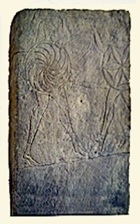
Perugia
Alfabetario di Perugia (late 6th century BC)
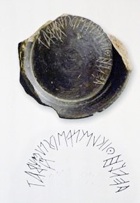
✴The main part of the inscription sets out the Etruscan alphabet, using 19 letters from the version of the Greek alphabet that was used in Corinth. This is in a form that is typical of those from Chamars (Chiusi) at this period.
✴The last four letters seem to have been added later: they are transcribed as “abat”, which might mean “alphabet” or perhaps “a, b” (as in the English expression “abc” for the alphabet).
The “alfabetario” is now in the Museo Archeologico, Perugia.
Ipogeo degli Acsi (late 6th or 5th century BC)
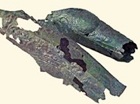
arnth savpunias turce menrvas
Arnth Savpunius gave [these] to Menrvas (Minerva)
It is possible that the shin guards were dedicated at Volsinii (Orvieto), and that they found their way to Perusia and more specifically to the Tombe degli Acsi after the fall of Volsinii in 264. They are now in the Museo Archeologico, Perugia.
Orvieto
Funerary Inscription (6th century BC)
A tomb in the Cannicella Necropolis has an interesting Etruscan inscription:
[m]i aviles katacinas"
I am [the tomb of] Aviles Katacinas
The deceased had an Etruscan-Latin first name (Aule, Aulus) and a family name that is probably of Celtic origin.
Inscription (ca. 550 BC)

This inscription “thval veal” reveals that the temple associated with the Cannicella Necropolis was dedicated to Vei (Demeter). It is now in the Museo Civico.
Inscribed Warrior Head (ca. 550 BC)
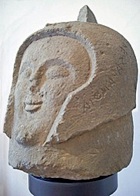
larth cupures aranthia
Larth Cuperes, son of Aranth
This name is unlike others found in Orvieto, and it is thought that Larth might have been a foreign mercenary who settled in the city.
The cippus is now in the Museo Civico.
Funerary cippus (late 6th century BC)
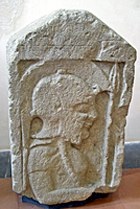
Inscribed Base for a Statue (ca. 500 BC)
The Etruscan inscription, which is in two lines on each of two sides, has been transcribed:
kanuta larecenas lauteniθa aranθia pinies puia turuce
tlusχval marveθul faliaθere
Kanuta, freedwoman of the Larecena, wife of Aranth Pinie, has offered ... [this statue?] to Tluschva
This deity is named three times on the famous “Piacenza Liver” (as “Tlusc”, “Tluscv”, “Mar Tlusc”) and also appears in another recently-discovered inscription from Cerveteri. This deity (or group of deities) is usually taken to be female, and to be chthonic (related to the underworld):
✴“Tluschval” (as in the Orvieto inscription) seems to be a genitive form of the plural;
✴in his webpage, Glen Gordon suggests that “Tluschva” is “a single god [named for] a pluralized inanimate concept”, specifically “depths”.
The translation of the fuller name in the inscription at Orvieto (“tlusχval marveθul faliaθere”) is still debated among scholars:
✴ Giovanni Colonna (referenced below) suggests that “marveθul” derives from “maru” (magistrate).
•He goes on to suggest that, in this inscription, it is an epithet that signifies “minister, acolyte or helper”, perhaps of Hades, the god of the underworld; while
•Simonetta Stopponi (referenced below, at p. 39) suggests that the magistracy in question was connected to the construction of public buildings, and translates “marveθul” as “of the seat or residence”.
✴“faliaθere” might be a locative related to “faladum”, a Latinised Etruscan word that Festus translated as “coelum” (heaven). Simonetta Stopponi (in the appendix mentioned above) translates it as “in the celestial place”, and tentatively suggests that this is the Etruscan name for the sanctuary at Campo della Fiera.
The inscription is now in the Museo Archeologico.
Inscription (ca. 4th century BC)
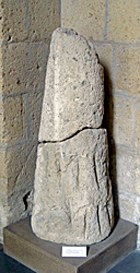
TINIA TINSCVIL
and probably formed part of an altar dedicated to Tinia (Zeus, Jove) from a temple on the site.
Inscriptions from Golini Tombs I and II (4th century BC)
The archaeologist, Domenico Golini discovered the so-called Golini tombs in 1863 in a hillside at Settecamini, outside Orvieto. They belonged to a number of aristocratic families that had probably had country estates nearby. Two of the tombs (Golini I and Golini II), which were on the higher part of the hillside, were distinguished by a series of frescoes painted on their walls. These were detached in 1950 and moved to the Museo Archeologico of Florence. They were transferred to Orvieto in 1982 and are now displayed in the Museo Archeologico.
Golini Tomb I
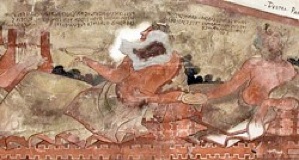
The most important inscriptions on these frescoes describe two men who were presumably buried in the tomb, and who are portrayed at a banquet in the Underworld:
Arnth Leinies; and
Vel lecates, brother of Arnth,
both of whom are described as “son of Larth, grandson of Vel”.
Vel Lecates
Vel lecates arnthial ruva larthialisa clan velusum nefs
marniu spurana eprthnec tenve
mechlum rasneas clevsinsl zilachnve
pulum rumitrine thi ma[l]ce clel lu(puce) (TLE 233)
The first line identifies Vel as “brother of Arnth, son of Larth, grandson of Vel”. Jacques Heurgon (referenced below) suggests that “lecates” was an honorific meaning “legate” or ‘emissary”. In the last line of the inscription, which presumably describes the high point of Vel’s public career, relates something that he did : “pulum rumitrine”, which Heurgon suggests means “in Rome”.
Adriano Maggiani (referenced below) has used this and similar inscriptions to establish the names of the various magisterial offices used in the cities of Etruria in the pre-Roman period. Those that had been held by Vel are listed in the inscription as:
maru - marunuch;
purth - eprnevc; and
zilath - zilach.
The words in these pairs are related as in: “magistrate - magistracy”, and are listed here in ascending order of seniority. Adriano Maggiani makes the following observations on the way some of these magistracies are qualified.
✴In “marniu spurana”, the word spurana seems to mean “civic”, ‘urban” or “public”.
✴The office of “zilath mecl rasnal” seems to have been the highest in each of the Etruscan city states. If this is correct, then as “mechlum rasneas clevsinsl zilachnve”, Vel would be the chief magistrate of Clevsin (Chiusi).
Arnth Leinies
Arnth Leinies larthial clan velusum nefts
ailf() marunuch tef esari
'ru[va] l[ecates velus] amce (TLE 234)
The first and last lines identify Arnth as “brother of Vel, son of Larth, grandson of Vel” and “brother of Vel lecates” respectively. The magistracy held by Arnth might have been religious in character.
Vel Leinies Junior
Vel leinies larthial ruva arnthialum clan velusum prumaths
avils semphs lupuce (TLE 232)
Vel Leinies, brother of Larth (junior), son of Arnth, great grandson of Vel
he died (lupuce) at the age of 7
This younger Larth, Vel’s brother, is identified in the fresco as a young man driving a chariot towards the Underworld to join Vel, their father Arnth and their uncle (Arnth’s brother) Vel lecate.
Golini Tomb II
Golini Tomb II is also known as the tomb of the two chariots because of the chariots that were depicted on each side of the entrance. The other walls depicted scenes from a feast in the underworld. The inscriptions refer to two families: Cnezus on the left; and Vercnas on the right.
Read more:
D. Feeney, “Beyond Greek: The Beginnings of Latin Literature”. (2016) Cambridge MA and London
G. Colonna, “I Santuari Comunitari e il Culto delle Divinità Catactonie in Etruria”, in:
G. della Fina (Ed.), “Il Fanum Voltumnae e i Santuari Comunitari dell’ Italia Antica”, (2012) Orvieto, at pp 203-26
J.Macintosh Turfa, “Divining the Etruscan World”, (2012) Cambridge
S. Stopponi, “Campo della Fiera at Orvieto: New Discoveries”, in:
N. de Grummond and I. Edlund-Berry (Eds), “Archaeology of Sanctuaries and Ritual in Etruria”, Journal of Roman Archaeology (Supplement 81), (2011) Portsmouth, Rhode Island, pp 16-44
L. Bonfante, “Etruscan Inscriptions and Etruscan Religion”, in:
N. Thomson de Grummond and E. Simon, “Religion of the Etruscans”, (2006) Texas, at pp. 9-26
A. Maggiani, “Republican Political Forms”, in
M. Torelli (Ed.), “The Etruscans”, (2000 ) New York, pp. 227-41
L. Bonfante, “Etruscan”, in
J. T. Hooker et al., “Reading the Past: Ancient Writing from Cuneiform to the Alphabet”, (1990) Berkeley and Los Angeles, at p. 321-78
G. and L. Bonfante, “The Etruscan Language: An Introduction”, (1988), Manchester and New York
J. Heurgon, “Un Legatus à Volsinii: à Propos des Inscriptions de la Tombe Golini I”, Mélanges de l'Ecole Française de Rome: Antiquité, 86:2 (1974) 707-21
The Etruscans: Main page Etruscan Language and Culture
Early Etruscan Inscriptions Etruscan Religion
Return to the History Index